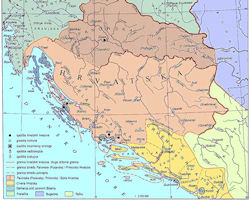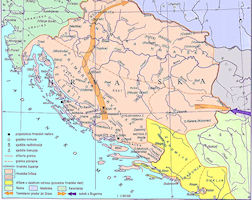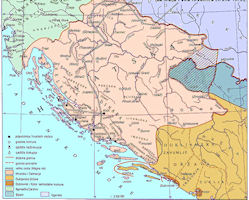The Medieval Independent Croat Kingdom
 Medieval historians did not use the terms Croatia and Slavonia in their present sense. The Croatia of the middle ages comprised north-western Bosnia, Turkish Croatia, and the region now known as Upper Croatia. The whole country between the Drave and Save, thus including a large part of modern Croatia, was called in Latin Slavonia, in German Windisches Land, and in Hungarian Tdtorstdg, to distinguish it from the territories in which the Croats were supreme (Horvdlerszdg).
Medieval historians did not use the terms Croatia and Slavonia in their present sense. The Croatia of the middle ages comprised north-western Bosnia, Turkish Croatia, and the region now known as Upper Croatia. The whole country between the Drave and Save, thus including a large part of modern Croatia, was called in Latin Slavonia, in German Windisches Land, and in Hungarian Tdtorstdg, to distinguish it from the territories in which the Croats were supreme (Horvdlerszdg).
Most historians believe that the Croats are a purely Slavic people who probably migrated to the Balkans from the present-day Ukraine. A newer theory, however, holds that the original Croats were nomadic Sarmatians who roamed Central Asia, migrated onto the steppes around 200 BC, and rode into Europe near the end of the fourth century AD, possibly together with the Huns.
The Croats were a Slavonic people from the western Carpathians, who, according to some authorities, had occupied the territories of the Marcomanni in Bohemia, and been driven thence in the 6th century by the Czechs. The main body of the Croats, whose tribal and racial names respectively are perpetuated in the names of Croatia and Slavonia, entered Croatia between 634 and 638, and were encouraged by the emperor Heraclius to attack the Avars. Smaller bodies had led the way southwards since 548. The Croats formed the western division of the great migratory horde of Serbo-Croats which colonized the lands between Bulgaria and the Adriatic.
The Sarmatian Croats, the theory holds, conquered the Slavs of northern Bohemia and southern Poland and formed a small state called White Croatia near today's Kraków. The Croats then supposedly mingled with their more numerous Slavic subjects and adopted the Slavic language, while the subjects assumed the tribal name "Croat. Contemporary chroniclers called them Chrobali, Belochrobati ("White Croats"), Chrovati, Horvati, or by some similar Latin or Byzantine variant of the Slavonic Khrvaty.
 By the 7th Century Croatian tribes begin to settle on the territory of the Roman regions of Dalmatia, Panonia and Istria. The Croats occupied most of the regions later known as Croatia-Slavonia, Dalmatia, and north-western Bosnia, displacing or absorbing the earlier inhabitants everywhere except along the Dalmatian littoral, where the Italian city-states usually maintained their independence, and in certain districts of Slavonia, where, out of a mixed population of Slavonic immigrants, Avars and Pannonians, the Slavs, and especially the Serbo-Croats, gradually became predominant.
By the 7th Century Croatian tribes begin to settle on the territory of the Roman regions of Dalmatia, Panonia and Istria. The Croats occupied most of the regions later known as Croatia-Slavonia, Dalmatia, and north-western Bosnia, displacing or absorbing the earlier inhabitants everywhere except along the Dalmatian littoral, where the Italian city-states usually maintained their independence, and in certain districts of Slavonia, where, out of a mixed population of Slavonic immigrants, Avars and Pannonians, the Slavs, and especially the Serbo-Croats, gradually became predominant.
The Croats brought with them their primitive tribal institutions, organized on a basis partly military, partly patriarchal, and identical with the Zhupanates of the Serbs; agriculture, war and hunting were their chief pursuits. Although they at first acknowledged no alien sovereign, they passed gradually under Italian influence in the extreme west, and under Byzantine influence in the south and south-east.
In the year 852, Prince Trpimir in his identification calls himself "with God's grace the ruler of the Croats", the oldest preserved mention of the Croat name. A tenth-century Byzantine source reports that in the seventh century Emperor Heraclius enlisted the Croats to expel the Avars from Byzantine lands. The Croats overran the Avars and Slavs in Dalmatia around 630 and then drove the Avars from today's Slovenia and other areas. In the eighth century, the Croats lived under loose Byzantine rule, and Christianity and Latin culture recovered in the coastal cities. The Franks subjugated most of the Croats in the eighth century and sent missionaries to baptize them in the Latin rite, but the Byzantine Empire continued to rule Dalmatia.
Croatia emerged as an independent nation in 924. Tomislav (910-c. 928), a tribal leader, established himself as the first king of Croatia, ruling a domain that stretched eastward to the Danube. Croatia and Venice struggled to dominate Dalmatia as the power of Byzantium faded, and for a time the Dalmatians paid the Croats tribute to assure safe passage for their galleys through the Adriatic. After the Great Schism of 1054 split the Roman and Byzantine churches, Normans (probably with papal support) besieged Byzantine cities in Dalmatia. In 1075 a papal legate crowned Dmitrije Zvonimir (1076-89) king of Croatia.


|
NEWSLETTER
|
| Join the GlobalSecurity.org mailing list |
|
|
|

